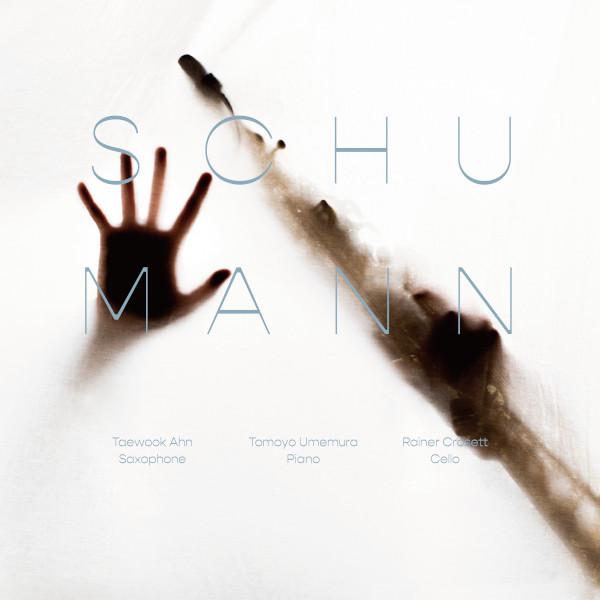
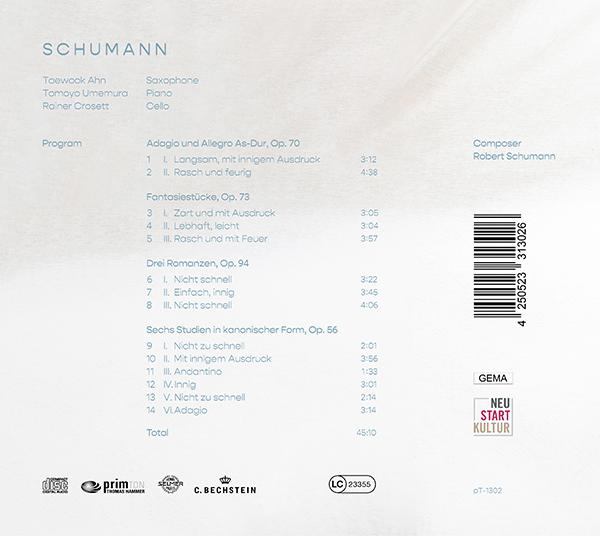



Schumann
Taewook Ahn (Soprano Saxophone), Tomoyo Umemura (Piano), Rainer Crosett (Cello)
Robert Schumann (1810-1856):
Adagio und Allegro op. 70 (1. Langsam, 2. Rasch und feurig)
Robert Schumann (1810-1856):
Fantasiestücke op. 73 (1. Zart mit Ausdruck, 2. Lebhaft, leicht, 3. Rasch und mit Feuer)
Robert Schumann (1810-1856):
Drei Romanzen op. 94 / Three Romances Op. 94
(1. Nicht schnell, 2. Einfach, innig, 3. Nicht schnell)
Robert Schumann (1810-1856):
Sechs Studien in kanonischer Form op. 56 / Six studies in canonic form Op. 56
(1. Nicht zu schnell, 2. Mit innigem Ausdruck, 3. Andantino, 4. Innig, 5. Nicht zu schnell, 6. Adagio)
Aufnahme: 08.05. und 20.05.2021 im Tonstudio Ölberg-Kirche in Berlin-Kreuzberg, Tonmeister: Hannes Baier
TT 45:10 Min., Bestellnummer: pT-1302, EAN 4250523313026, primTON 2021
Youtube-Videos
Schauen Sie sich bei Youtube Videos an:
 [Schumann] Promotion Video (short)
[Schumann] Promotion Video (short)
 [Schumann] Project Promotion Music Video
[Schumann] Project Promotion Music Video
Taewook Ahn or the saxophone as embodiment of romantic aesthetics.
The sound of the saxophone is not commonly associated with romantic classical music. One could even think of Schumann's music as an awkward choice for the instrument; Taewook Ahn proves the opposite to be true, right from the first note of this album. What better vessel than the saxophone, indeed, could embody the intrinsical contradictions of romantic aesthetics? What could encapsulate the soul of the 19th century better than this elegant hybrid of wood and brass? More than a mere list of transcriptions, this album provides a rediscovery of some of the most iconic pages in romantic literature. Tomoyo Umemura, Taewook Ahn and Rainer Crosett bring unheard colors into some of Schumann's most intimate works, exposing the very fabric of its texture – with sensuality, playfulness and taste. A young, convincing, resolutely modern take on beautiful classics.
One usually doesn't make a connection between the Romantic repertoire and the saxophone, and it would seem natural to question this unusual combination. Robert Schumann, whose pieces are featured in this album, probably never even heard the instrument, let alone compose for it; only decades after his death would it start to be routinely integrated to ensembles of classical music. However, there is a paradox to this intuitive separation: in a way, the saxophone might in fact represent the acme of Romantic instrumental development.
The 19th century was rich in terms of technological advances. For instance, the 1830's had already seen the major development of horn valves, which would change the landscape of Western music forever: this system would guarantee unprecedented agility to brass players in all possible keys. The context in which Adolphe Sax developed his own additions to woodwind instruments was a time in which industrialisation was making technological advances not only possible, but also broadly available. From a musical perspective, it was a time in which instruments were progressively designed towards equal temperament, giving them full freedom in terms of tonality. At the same time, composers were looking for new sonorities, both within the orchestra and in smaller configurations; this research for original colors would often focus on winds rather than stringed instruments.
By adding the sparks of the brass sound to the smoothness and flexibility of the single reed, the saxophone embodies both the technical and aesthetic struggles of the 19th century, as well as their answer. In this sense, it is a unique product of its time – one could argue that it even begs to perform the very music it was born within. Indeed, what instrument would be more adequate in representing the Schumannian duality of Eusebius and Florestan than the ambiguously sounding saxophone, which Fétis described as both brass and woodwind?
The six Studies in canonical form Op. 56 were originally composed for the pedal piano, an instrument featuring an additional pedal keyboard, similar to that of an organ. This would allow for greater polyphonic possibilities, as is displayed in these pieces. Pedal pianos having largely fallen out of fashion, these pieces are rarely performed, and not known to the general public. In this context, Theodor Kirchner's arrangement for piano, cello and saxophone (originally violin) is particularly intelligent: not only does it allow the pieces to be heard, relieving them of the impracticality of their instrumentation, but it even enhances their features.
Each piece's canon materialises mainly as a dialog between the saxophone and the cello, embedded inside a pianistic texture. All protagonists sing in contrast, chiseling the polyphonic intricacies and enhancing them using the bright colors of their timbres. The result is fluid, transparent, expressive; this little-known music, which deserves to be heard, really comes to shine. Taewook Ahn, Tomoyo Umemura and Rainer Crosett spectacularly bring the musical substance out of what could have remained a simple collection of contrapuntal studies.
Bach's spectre haunts every bar of the first one, in C-Major. Its endless arabesques and complementary rhythms sound like a nostalgic homage to Baroque counterpoint, and make for a beautiful opening chapter, in the fashion of Inventions or Preludes.
The second piece (mit innigem Ausdruck) showcases the playful exchange that occur between the three musicians: voices wrap around each other in a slow, ternary rhythm, swinging calmly and unraveling the most expressive inflections along Schumann's masterfully crafted sequences.
The third one is another little gem; it reminds of Mendelssohn's songs without words, with its cyclical form: a slow, somewhat well-mannered introduction by the piano is brought back at the very end, contrasting with the core of the piece itself. Here, the canon is shared between the saxophone and the cello, whose short phrases and turns jump like jests, while the piano adds its staccato touch to the bouncy atmosphere.
The fourth one (in A-Flat Major, “Innig”) adds some dramatic substance to the set: it starts with a beautiful duo, reminiscent of love scenes in Opera. The mellow sound of the four-flats key add to the impression of idyllic intimacy; but suddenly clouds obscure the sky, and a surprisingly agitated section beginns (in F-Minor). Fast figures in the accompaniment push the music forward, while the two soloists exchange painful sighs. The ending is peaceful again, in spite of the quick notes of the piano that shine through discreetly, now tamed by the idyllic theme of the opening.
The crispy staccato makes the fifth one (in B-Minor, “Nicht zu schnell”) sound like some sort of Russian dance. A very playful interlude, uncomplicated, light and airy, before the finale.
A majestic Adagio (in B-Major) concludes Op.56, with a serious touch – nevertheless without ever becoming austere. After a short introduction, the piano starts what seems like the beginning of a three part fugue (in G-Sharp-Minor), which in turn is interrupted prematurely by the broad, song-like, romantic texture of the beginning. This second nod to Johann Sebastian Bach gives a sense of closure to the entire set, bringing, in a way, the counterpart of the first piece.
The Fantasiestücke Op. 73, originally written for the clarinet, are some of Schumann's most popular chamber music pieces. Like most pieces featured in this album, he wrote them in 1849, a time he described to Ferdinand Hiller as “the worst year” (“das furchtbarste Jahr”). Aggravating external factors (one might think, for instance, of the political turmoil that was ravaging Europe) are maybe what pushed the composer to turn himself to a more introspective music, a music whose freedom of form would recall the unpredictable flow of human imagination.
The three “fantasy pieces” are to be played “attacca” (without any break between movements), coming together to paint a sort of poetic landscape. The first movement (in A-Minor, Zart und mit Ausdruck) invokes a melancholic, almost dream-like atmosphere, with its luscious cantilene hovering above the triplets of the piano accompaniment. The middle section drifts towards a short passage in F-Major, in which time seems to briefly stop, suspended, floating, before a sequence brings the music back to its reality, towards its conclusion.
The second movement (in A-Major, “Lebhaft, leicht”) is more exuberant, and uses a motif previously hidden inside the piano accompaniment as its first theme. It is again the key of F-Major that provides the greatest contrast: for a brief moment, the music interrupts its flow, and both protagonists sink into a mellow color – quiet, almost otherworldly, but still retaining its lightness in character.
Virtuosity and electricity would best describe the third movement (in A-Major, “Rasch und mit Feuer”). It brings back the poetic theme of the first movement in a heroic, agitated fashion, giving it an even more bittersweet quality. The piece switches to the minor mode for a melancholic parenthesis, before driving the listener into a frantic, ever accelerating coda; this wild, epic atmosphere concludes one of Schumann's most iconic pages.
It is not only a quest for introspection or retreat that pushed Schumann to compose intimate chamber music pieces. He was also undergoing a rational research of sound, and was attempting to balance out the classical repertoire, giving “underperformed” instruments a chance to shine within a smaller ensemble. The oboe was one of those, whose presence had been self-evident in orchestras for several decades but was rarely heard as a soloist; hence the Romanzen Op. 94 were born. On the surface, these pieces bear some similarity to the Fantasiestücke: their length, some of their tonalities, their freedom of form. However, there are some significant differences between the two.
First of all, while the Fantasiestücke formed a coherent whole, to be performed attacca, the Romanzen are independent pieces. Their tone is also different: right from the beginning of the first piece (in A-Minor, “nicht schnell”), the melody takes an unmistakably narrative, epic turn. This opus therefore seems to be more reminiscent of legends, as understood by German Romanticism – the imaginary world that will soon give birth to Wagner's operas, filled with heroes and ancient gods – than expressing an intimate, personal state of mind.
The second piece (in A-Major, “Einfach, innig”) starts with a calm, radiant pastoral color, which at first remains almost untouched by minor clouds. Then suddenly, an abrupt change in character rips through the scenery: a darker color takes over (the phrygian semitone, on which the melody insists!) and the piano's accompaniment rushes the tempo, as if out of breath. This momentary storm passes quickly, but its memory leaves a shadow on the recapitulation (notice the wonderful F-Major chord in the coda! A delicious, bittersweet surprise).
The third piece (in A-Minor, “nicht schnell”), returns to the narrative tone of the first one, with the piano and saxophone going in unison. This deceptively simple beginning will give birth to a multitude of intricate ideas: Schumann is surprisingly detailed in his tempo wishes, telling both protagonists when to slow down and breathe, and when to catch up with the pace. A wonderful middle section (in F-Major) offers a contrast, and acts as a steppingstone for the Coda, whose Neapolitan color gives the conclusion its own, truly unique, appeal.
The Adagio and Allegro Op. 70 was composed right after the Fantasiestücke and was originally conceived as a piece for horn and piano. It remains, to this day, one of the most important pieces of the repertoire for horn, partly due to its brilliant, very virtuosic setting. The transcription for soprano saxophone gives it a surprising air of agility, rendering it more aerial, almost feather-like in its quick, mercurial lines.
The first half of the diptych was first supposed to be titled “Romanze”, but Schumann decided to keep the more neutral tempo marking (“Adagio”) upon publication. The majestic opening theme is, in spite of its seemingly natural simplicity, very surprising in its construction: it follows a chiastic structure (A B B' A'), which is rare in classical music. This play with imitation and mirroring is going to be a recurring subject of the entire piece. Piano and saxophone imitate each other's motifs, giving them a new color with each iteration; this is the perfect opportunity for Schumann to display his harmonic inventiveness by surprising the listener with each turn of phrase. The coda of the Adagio is particularly unique, with its long pedal note and playful deceptiveness between D-Flat and A-Flat major, giving the impression of a somewhat archaic plagal cadence.
The Allegro (“Rasch und Feurig”) is everything we expected and more. It is a rondo, whose refrain crackles with repeated notes, driving the music forward in a wild dance – vaguely reminiscent of a tarantella. An abrupt change of color (from A-Flat Major to B-Major, “Etwas ruhiger”) brings a moment of halt within the storm. Schumann uses this opportunity to discreetly increase the density of the music: piano and melody sing in canons, developing the contrapuntal nature which the introduction was foreshadowing. This exchange culminates in a spectacular enharmonic modulation, back to the realm of flats, which triggers an electrifying accelerando back to the first theme. After a long, tantalising dominant pedal tone, the ending finally materialises as a spectacular, exhilarating display of virtuosity, in which both soloists join forces for one last short burst of speed.
Matthieu Stepec
Leider sind noch keine Bewertungen vorhanden. Seien Sie der Erste, der das Produkt bewertet.
Sie müssen angemeldet sein um eine Bewertung abgeben zu können. Anmelden



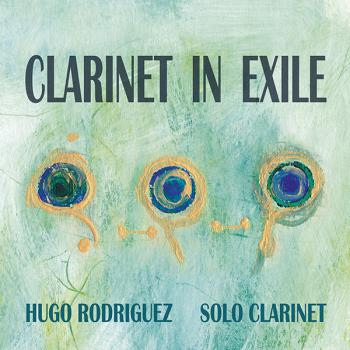
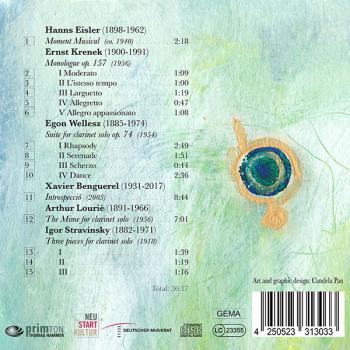
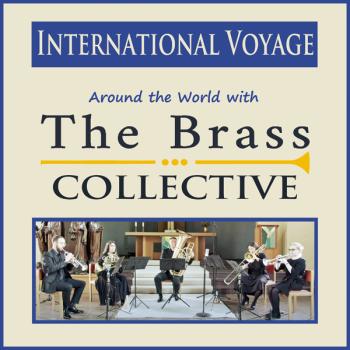
.jpg)